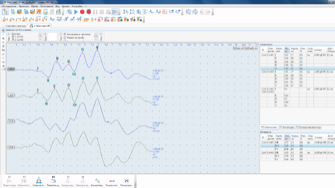Catalog

TEKHNOYAKS
61 products
View:
Telephone number:
E-mail:
mail@tehnojaks.ru
Website: https://tehnojaks.com
Address:
Russia, Moscow, null, 30null
Сайт:
https://tehnojaks.com
Адрес:
Russia, Moscow, null, 30null
- Selected: 0Applying
- Selected: 0Names
- Selected: 0Manufacturer
- Selected: 0Made in
- Selected: 0Additional
View:
51 products
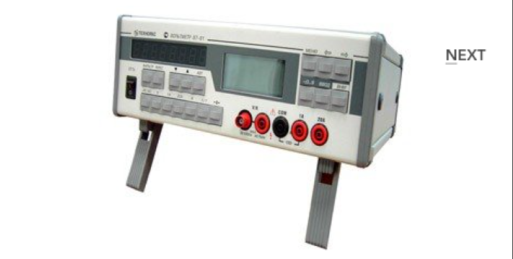
Universal voltmeter V7-81
The voltmeter is capable of operating both independently and as part of automated measuring systems with RS-232 type interfaces.
Technical specifications
Ranges of measurement of electrical quantities:
- constant electrical voltage from 10 MV to 1000 V
- SCR of alternating electric voltage in the frequency range from 10 Hz to 10 MHz (AC) from 1 mV to 750 V
- DC current from 0.1 µA to 20 A
- SCR of alternating electric current in the frequency range from 10 Hz to 5 kHz from 10 µA to 20 A
- electrical resistance from 10 mOhm to 1 GOm
- frequency of the measured alternating electric voltage from 10 Hz to 1 MHz
Measurement errors of electrical quantities:
- constant electrical voltage ± (0.0028 - 20)%
- SCR of alternating electric voltage in the frequency range from 10 Hz to 10 MHz (AC) ± (0.09 - 15)%
- DC power ± (0.012 - 20)%
- SCR of alternating electric current in the frequency range from 10 Hz to 5 kHz ± (0.11 - 2.35) %
- electrical resistance ± (0.007 - 5.5)%
- frequency of the measured alternating electric voltage ± (0.1 -10.1)%
General characteristics:
Operating temperature range from 5 to 40 °C
AC power supply 220 V, 50 Hz
Power consumption, no more than 20 VA
Overall dimensions, mm 291x110x308
Weight, not more than 4.5 kg
TEKHNOYAKS
Moscow
Produced in: Moscow
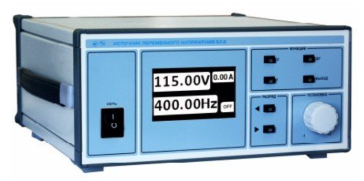
AC voltage source B2-9
The source is capable of operating both independently and as part of automated measuring systems with interfaces such as RS-232 and ETHERNET.
Technical specifications
Output voltage setting range (SCR) from 25 to 250 V
The discreteness of the output voltage setting is 0.05 V
The frequency setting range of the output voltage is from 40 to 500 Hz
The discreteness of the output voltage frequency setting is 0.05 Hz
Output electrical power, not less than 1000 VA
The basic error of setting the output voltage is ± (0.005 Uv + 0.5 V)
The basic error of setting the output voltage frequency is ± 0.1 Hz
Additional error in setting the output voltage caused by a change in the load current from the maximum value to zero ± 0.5 V
Instability of the output voltage for any 10 minutes during 8 hours of continuous operation, no more than ± 0.5 V
Operating temperature range from minus 10 to 50 °C
AC power supply 220 V, 50 Hz
Power consumption, no more than 1300 VA
Overall dimensions, mm 343x160x352
Weight, not more than 6.5 kg
TEKHNOYAKS
Moscow
Produced in: Moscow
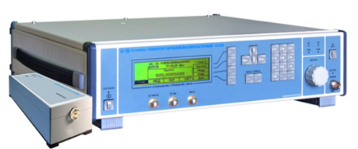
High-frequency signal generator G4-235, G4-236
Created on the basis of the G4-230 generator. Remote frequency converters extend the frequency ranges up to 53.57 GHz (G4-235) and up to 78.33 GHz (G4-236).
The generators are capable of operating both independently and as part of automated measuring systems with USB and IEEE-488 (CPC) interfaces.
Technical specifications
The frequency range at the output of the base unit is from 5 to 20 GHz
Frequency range at the output of the frequency converter (G4-235) from 37.5 to 53.57 GHz
The frequency range at the output of the frequency converter (G4-236) is from 53.57 to 78.33 GHz
Frequency tuning discreteness 0.001 Hz
The main error of the frequency setting is ± 3x10-7 Hz
The range of setting the signal power level at the output of the base unit is from minus 110 to 13 dBm
The range of setting the signal power level at the output of the frequency converter (G4-235) is from 0 to 13 dBm
The range of setting the signal power level at the output of the frequency converter (G4-236) from 0 to 10 dBm
The basic error of setting the reference power level is ± (1.0 – 2.5) dB
Metrological characteristics of the generator in FM operation mode:
- frequency range of the modulating signal from 1 Hz to 20 kHz
- frequency deviation setting range (taking into account the carrier frequency value) from 1 Hz to 200 kHz
- the main error of the frequency deviation setting is ± (5 – 18)%
Metrological characteristics of the generator in AM operation mode:
- frequency range of the modulating signal from 0.05 to 5.0 kHz
- the range of setting the amplitude modulation coefficient from 1 to 50 %
- the basic error of setting the amplitude modulation coefficient ± (0.15 M + 0.2)%
Metrological characteristics of the generator in the IM operation mode:
- the duration range of modulating pulses from 100 ns to 20 s
- the range of the modulating pulse repetition period from 140 ns to 30 s
- the difference in the duration of the output RF pulses from the duration of the modulating pulses ± 100 ns
Operating temperature range from 5°C to 40 °C
AC power supply 220 V, 50 Hz
Power consumption, no more than 150 VA
Overall dimensions, mm 498x136x487
Weight, not more than 20 kg
TEKHNOYAKS
Moscow
Produced in: Moscow
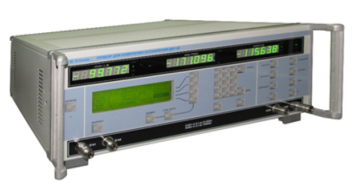
Device for measuring attenuation DC1-28
The device is capable of operating both independently and as part of automated measuring systems with USB and IEEE-488 interfaces (CPC).
Technical specifications
Frequency range from 100 kHz to 37.5 GHz
VSWR input of the device with a matching fixed attenuator attenuation of 10 dB, depending on the frequency range, no more
• from 100 kHz to 180 MHz 1.15
• from 0.18 to 2 GHz 1.25
• from 2 to 12 GHz 1.30
• from 12 to 17.85 GHz 1.50
• from 17.85 to 37.5 GHz 2.00
Operating temperature range from 5 to 40 °C
AC power supply 220 V, 50 Hz
Power consumption, no more than 125 VA
Overall dimensions, mm 216x493x508.5
Weight, not more than 32 kg
TEKHNOYAKS
Moscow
Produced in: Moscow
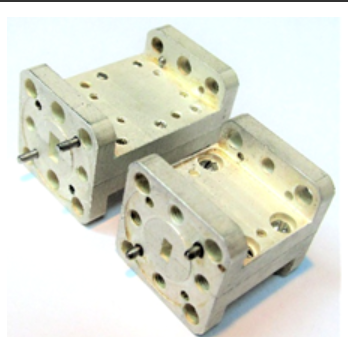
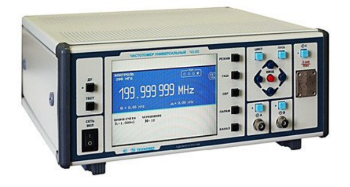
Universal frequency meter Ch3-95
The frequency meter is capable of operating both autonomously and as part of automated measuring systems with interfaces such as BUSB, RS-232, ETNET and IEEE-488 (CPC).
Technical specifications
Frequency and period of sinusoidal signals (inputs A, B) 0.001 Hz - 300 MHz
Frequency and period of video pulse signals (inputs A, B) 0.001 Hz - 300 MHz
Frequency of continuous sinusoidal oscillations (input C) (37.5 – 78.33) GHz
Pulse duration 5 ns - 1000 s
The duration of the front, the decay of the pulses is 5 ns - 100 microseconds
Time interval from -1000 to 1000 s
Frequency measurement resolution 2x10-10 s/Rng
Setting range of trigger levels (inputs A, B) from -2 to 2 V
The error of setting the trigger levels (inputs A, B) ± 0.01 V
Input signal level:
•for sinusoidal signal (inputs A, B) (0.03 - 10.0) V
•for video pulse signal (inputs A, B) (0.1 - 10.0) V
•for a sinusoidal signal (input C) 0.5 MW - 5 MW
Input resistance
•Inputs A, B (50±2.5) ohms; (1±0.1) MOm/100 pF
•Input With (50±2.5) ohms
Nominal frequency value of the reference quartz oscillator 10 MHz
Relative error in the frequency of the quartz oscillator, no more than ± 2x10-7 in 24 months
Operating temperature range from minus 10 to 40 °C
AC power supply 220 V, 50 Hz
Power consumption, not more than 100 VA
Overall dimensions, mm 299x130,5x433
Weight, not more than 8.5 kg
TEKHNOYAKS
Moscow
Produced in: Moscow
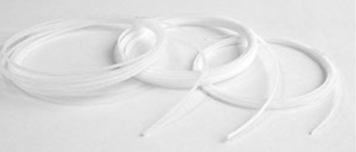
VD-3.6×1.8
A flexible waveguide is a piece of high-quality dielectric, which ends with transitions to standard waveguides with flanges.
For ease of operation, the waveguide is protected by an elastic shell.
Basic properties
Manufacturability of the connection;
Small losses and VSWR;
Economy.
Operating conditions
Operating temperature range from 5 to 50 ° C;
The relative humidity of the air is up to 98% at a temperature of 25 ° C.
Technical specifications
Waveguide cross section, mm 3.6×1.8
Flange type according to GOST RV 51914-2002
Frequency range, GHz 53.57-78.33
VSWR 1.25
Losses, 2.5 dB
Length, mm* 500
TEKHNOYAKS
Moscow
Produced in: Moscow
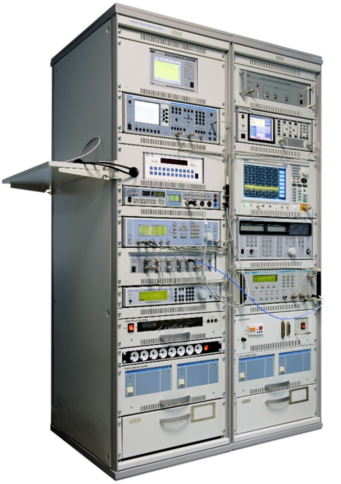
PM-8 verification module
The composition of the PM-8 verification module
Frequency comparator CHK7-1011;
Universal frequency meter Ch3-89;
AC voltage voltmeter VK3-78A;
Universal voltmeter V7-81;
AC voltage calibrator H5-5;
High-frequency signal generator G4-227;
High-frequency signal generator G4-229;
High-frequency signal generator G4-230;
Absorbed power wattmeter M3-108;
Installation for measuring attenuation D1-24/1;
Device for measuring attenuation stepwise D1-25;
Computational modulation meter SK3-49;
The meter-calibrator of the harmonic coefficient SK6-20;
Spectrum analyzer SK4-"Belan 240";
VSWR panoramic meter R2-135;
VSWR panoramic meter R2-137;
A set of exemplary measures of the transmission coefficient H3-7;
Oscilloscope S1-157/4;
DC power supply B5-79/1;
AC power source B2-7 (2 pcs.);
Electronic switch of microwave signals;
PC, printer;
Basic load-bearing structures (BNC).
Technical specifications
Measuring ranges of electrical quantities:
Constant electrical voltage from 3 MV to 1000 V
Alternating electric voltage in the frequency range of 10 Hz ... 2000 MHz from 10 mV to 100 V
Frequency of continuous electromagnetic oscillations from 0.001 Hz to 17.85 GHz
The power of continuous electromagnetic oscillations in the frequency range of 20 MHz ... 17.85 GHz from 0.8 to 10 MW
Attenuation of electromagnetic oscillations in the frequency range 0.1 MHz ... 17.85 GHz from 0 to120 dB
VSWR in the frequency range 0.2 ... 17.85 GHz from 1.03 to 2
Harmonic coefficient in the frequency range of 10 Hz ... 8 GHz from 0.005 to 100 %
The amplitude modulation coefficient in the carrier frequency range of 100 kHz ... 17.85 GHz from 0.1 to 100 %
Frequency deviation in the carrier frequency range of 100 kHz ... 17.85 GHz from 5 Hz to 1 MHz
Phase modulation index in the carrier frequency range 100 kHz ... 17.85 GHz from 1 to 100 radians
Phase shift between two harmonic signals in the frequency range 0.1 MHz ... 17.85 GHz from 0 to 360o
Ranges of reproduction of electrical quantities:
Alternating electrical voltage in the frequency range of 10 Hz ... 2000 MHz from 3 MV to 3 V
Harmonic (sinusoidal) signal at a load of 50 ohms in the frequency range of 0.001 Hz ... 30 MHz from 0.01 to 5 V
Continuous electromagnetic oscillations in the frequency range of 9 kHz ... 17.85 GHz from minus 120 to 13 dBm
5 and 10 MHz reference frequency signal
Attenuation of electromagnetic oscillations in the frequency range 0 ... 3 GHz from 0 to 86 dB
Measurement errors of electrical quantities:
Constant electrical voltage ± (0.0025 ... 16.7) %
Alternating electric voltage in the frequency range 10 Hz ... 2000 MHz ± (0.2 ... 16) %
Frequency of continuous electromagnetic oscillations ± (2·10-7 ... 4·10-3)
Power of continuous electromagnetic oscillations in the frequency range 20 MHz ... 17.85 GHz ± (4 ... 6) %
Attenuation of electromagnetic oscillations in the frequency range 0.1 MHz ... 17.85 GHz ± (0.01 ... 1.2) dB
VSWR in the frequency range 0.2 ... 17.85 GHz ± (3 ... 5) K
Harmonic coefficient in the frequency range 10 Hz ... 8 GHz ± (0.005 ... 6) %
Amplitude modulation coefficient in the carrier frequency range 100 kHz ... 17.85 GHz ± (0.1 ... 9) %
Frequency deviation in the carrier frequency range 100 kHz ... 17.85 GHz ± (0.2 ... 80) Hz
Phase modulation index in the carrier frequency range 100 kHz ... 17.85 GHz ± (0.02 ... 5) radians
Phase shift between two harmonic signals in the frequency range 0.1 MHz ... 17.85 GHz ± (0.01 ... 0.08) o
Errors in the reproduction of electrical quantities:
Alternating electrical voltage in the frequency range 10 Hz ... 2000 MHz ± (0.16 ... 10) %
Harmonic (sinusoidal) signal at a load of 50 ohms in the frequency range 0.001 Hz ... 30 MHz ± (3 ... 5) %;
Continuous electromagnetic oscillations in the frequency range of 9 kHz ... 17.85 GHz ± (0.5 ... 3) dB
5 and 10 MHz reference frequency signal ± (2·10-11 – 2,4·10-10)
Attenuation of electromagnetic oscillations in the frequency range 0 ... 3 GHz ± (0.2 ... 1.4) dB
General technical characteristics:
The area occupied by the module is 6-12 m2
Weight, not more than 550 kg
Power supply voltage from 198 to 242 V with a frequency of (50 ± 0.5) Hz
Power consumption, no more than 3000 VA
TEKHNOYAKS
Moscow
Produced in: Moscow
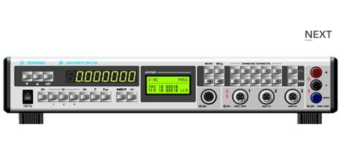
AC voltage voltmeter VK3-78A
The voltmeter is capable of working both independently and as part of automated measuring systems with interfaces such as USB, RS-232, IEEE-488 (CPC).
Technical specifications
Measuring ranges of electrical quantities:
- constant electrical voltage from 3 MV to 1000 V
- SCR of alternating electric voltage in the frequency range from 10 Hz to 1 MHz (AC) from 10 MV to 1000 V
- RF RF AC voltage in the frequency range from 10 Hz to 2000 MHz (RF) from 10 mV to 100 V
- frequency of the measured AC voltage from 10 Hz to 1 MHz
Measurement errors of electrical quantities:
- constant electrical voltage ± (0.0021 - 17)%
- SCR of alternating electric voltage in the frequency range from 10 Hz to 10 MHz (AC) ± (0.017 - 21)%
- RF RF AC voltage in the frequency range from 10 Hz to 2000 MHz (RF) ± (0.21 - 16)%
- frequency of the measured alternating electric voltage ± (0.1 -10.1)%
General characteristics:
Operating temperature range from 5 to 40 °C
AC power supply 220 V, 50 Hz
Power consumption, no more than 50 VA
Overall dimensions, mm 489x91x381
Weight, not more than 8.5 kg
TEKHNOYAKS
Moscow
Produced in: Moscow
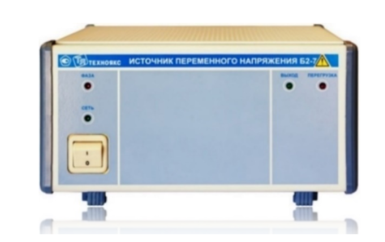
AC voltage source B2-7
The AC voltage source B2-7 is intended to provide devices and equipment with a stabilized AC voltage during the development, production, operation and repair of electronic devices.
Main properties:
Provides protection against overload and short circuits at the output.
Has a light indication:
- overload and short circuit protection tripping;
- incorrect connection of the power supply line to B2-7.
Technical specifications
The nominal value of the output voltage (SKZ) 220 V
The nominal value of the input and output voltage frequency is 50 Hz
Output electrical power, not less than 1000 VA
The main error in setting the output voltage is ± 2.2 V
Additional error in setting the output voltage caused by a deviation of the input voltage by ± 10% from the nominal value of 220 V ± 1.0 V
Additional error in setting the output voltage caused by a change in the load current from the maximum value to zero ± 2.0 V
Instability of the output voltage for any 10 minutes during 8 hours of continuous operation, no more than ± 2.0 V
Operating temperature range from -10 to 50 °C
AC power supply 220 V, 50 Hz
Power consumption, no more than 1200 VA
Overall dimensions, mm 240x128x349
Weight, not more than 6.5 kg
TEKHNOYAKS
Moscow
Produced in: Moscow
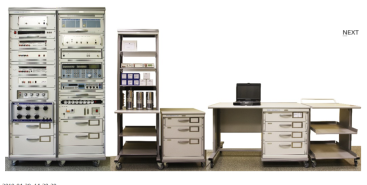
Verification module PM-9
The composition of the PM-9 calibration module:
Universal voltmeter calibrator H4-12 (2 pcs.);
Variable voltage calibrator H5-5A;
A measure of the stress ratio H4-8;
AC voltage voltmeter VK3-78A;
Generator-calibrator of harmonic signals SK6-122;
The meter-calibrator of the harmonic coefficient SK6-20A;
AC power source B2-7 (2 pcs.);
The measure of DC electrical resistance is multi-valued MS3070-2;
The measure of DC electrical resistance is multi-valued MS3055;
Decadal high-resistance resistance magazine M-109R;
Single-digit electrical resistance measures MS3080 (0.001; 0.01; 0.1 ohms);
Electrical resistance measures unambiguous MS3050M (1, 10, 100, 1000, 10000, 100000 Om);
The measure of electrical resistance is unambiguous P4013;
The measure of electrical resistance is unambiguous P4023;
The measure of electrical resistance is unambiguous P4033;
PC, printer;
Basic load-bearing structures (BNC).
Technical specifications
Measuring ranges of electrical quantities:
Constant electrical voltage DC from 1 MV to 1000 V
AC alternating electric voltage in the frequency range of 10 Hz ... 1 MHz from 10 mV to 1000 V
Alternating electric voltage high-frequency VRF in the frequency range of 10 Hz ... 2000 MHz from 10 mV to 100 V
Harmonic coefficient in the frequency range of 10 Hz ... 200 kHz from 0.001 to 100 %
Ranges of reproduction of electrical quantities:
Constant electrical voltage DC from 1 nV to 1000 V
AC alternating electric voltage in the frequency range of 10 Hz ... 1 MHz from 3 MV to 1000 V
Alternating electric voltage high-frequency VRF in the frequency range of 1 MHz ... 2000 MHz from 3 MV to 3 V
DC electric current from 1 µA to 20 A
The power of alternating electric current in the frequency range from 0.1 Hz to 10 kHz from 1 µA to 20 A
Electrical resistance from 0.001 ohms to 11
ohms Harmonic coefficient in the frequency range from 10 Hz to 200 kHz from 0.001 to 100 %
Measurement errors of electrical quantities:
Constant electrical voltage DC ± (0.0011 ... 4.0) %
AC alternating electric voltage, in the frequency range 10 Hz ... 1 MHz ± (0.0055 ... 1.2) %
Alternating electric voltage high-frequency VRF in the frequency range 1 MHz ... 2000 MHz ± (0.2 ... 6.0) %
Harmonic coefficient in the frequency range from 10 Hz to 200 kHz ± (0.0008 ... 2.0) %
Errors in the reproduction of electrical quantities:
Constant electrical voltage DC ± (0.0011 ... 4.0) %
AC alternating electric voltage in the frequency range 10 Hz ... 1 MHz ± (0.0055 ... 4.0) %
Alternating electric voltage high-frequency VRF in the frequency range 1 MHz ... 2000 MHz ± (0.6 ... 10.0) %
DC power ± (0.0033 ... 0.5) %
The power of alternating electric current in the frequency range from 10 Hz to 10 kHz ± (0.055 ... 1.0) %
Electrical resistance ± (0.001 ... 1.0) %
Harmonic coefficient in the frequency range from 10 Hz to 200 kHz ± (0.006 ... 2.0) %
General technical characteristics:
The area occupied by the module is 6-12 m2
Weight, not more than 430 kg
Power supply voltage from 198 to 242 V with a frequency of (50 ± 0.5) Hz
Power consumption, no more than 2000 VA
TEKHNOYAKS
Moscow
Produced in: Moscow
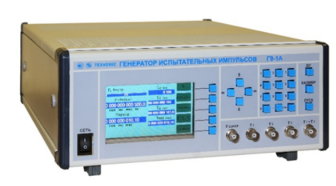
Generator of test pulses G9-1A
The generator is capable of operating both autonomously and as part of automated measuring systems with interfaces such as RS-232 and ITHERNET.
Technical specifications
The range of setting the pulse duration at the outputs:
- τ1 from 100 ns to 10 s
- t2 from 101 ns to 10.1 s
- t3 from 10 ns to 3600 s
The range of setting the time interval between the pulse fronts at outputs t1 and t2 (∆tx) is from 0 to 3600 s
The main error in setting the pulse duration at outputs t1 and t2 ± (δ0 • t1,2 + 1•10-8 c)
The basic error of setting the pulse duration at the output is τ3 ± (δ0 •τ3 + 2 •10-9 s)
The main error in setting the duration of the time interval (∆tx):
∆tx from 0 to 1000 s ± (δ0 •∆tx + 2•10-10 s)
∆tx from 1000 to 3600 s ± (δ0 •∆tx + 2•10-9 s)
Pulse amplitude at outputs τ1 , τ2 and τ3 at a load of 50 ohms, not less than 1.2 V
The nominal frequency value of the reference quartz oscillator is 10 MHz
Relative error in the frequency of the quartz oscillator (δ0 ), no more than ± 2x10-7 in 24 months
The pulse repetition frequency setting range at outputs τ4 and τ5 is from 0.1 Hz to 300 MHz
The main error in setting the pulse repetition frequency at outputs τ4 and τ5 ± δ0 •F = τ4.5
Pulse amplitude setting range at outputs τ4 and τ5 from 0.05 to 1 V
The main error in setting the pulse amplitude at outputs τ4 and τ5 ± 20%
Fixed values of pulse durations at the output of τ6 1 and 5 microseconds
The basic error of setting the pulse duration at the output is τ6 ± (0.2•τ6 + 3 •10-7 s)
The nominal value of the pulse repetition frequency at the output is τ6 100 kHz
The main error in setting the pulse repetition frequency at the output is τ6 ± δ0 •F = τ6
Fixed values of the pulse amplitude at the output of τ6 minus 10 V; minus 2.5 V; 2.5 V; 10 V
The main error in setting the pulse amplitude at the output is τ6 ± 20%
Operating temperature range from 5°C to 40 °C
AC power supply 220 V, 50 Hz
Power consumption, not more than 100 VA
Overall dimensions, mm 442x160x452
Weight, not more than 10 kg
TEKHNOYAKS
Moscow
Produced in: Moscow
